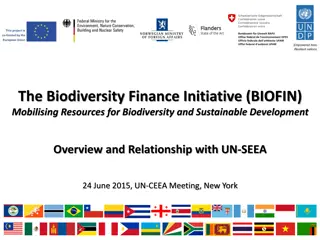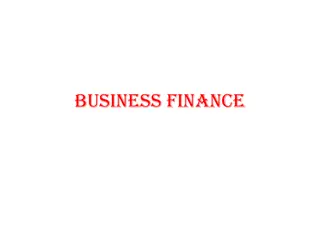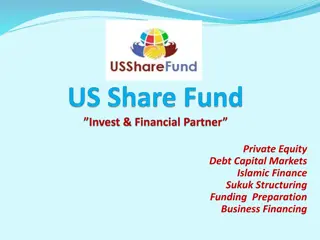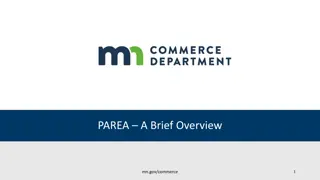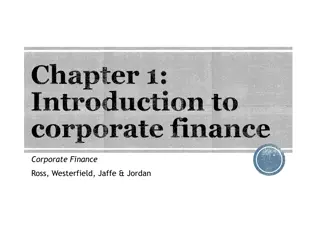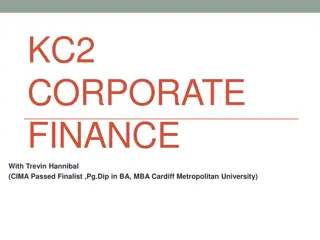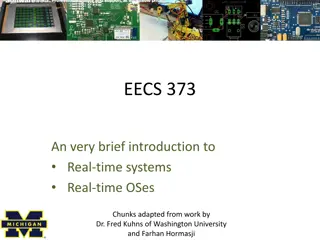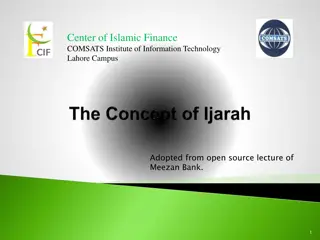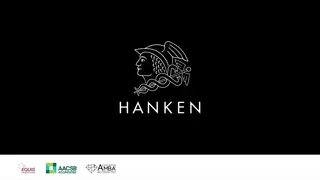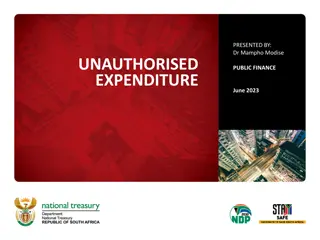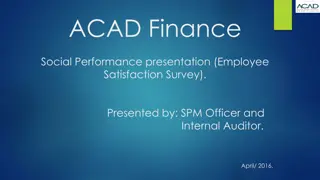Insights into International Finance: Concepts and Real-world Applications
Understanding key concepts in international finance such as Purchasing Power Parity (PPP), Derivation of exchange rates, International Fisher Effect, Direct Foreign Investment, and the advantages and disadvantages of targeting foreign countries for investments. Explore the dynamic landscape of finance with real-world examples and implications.
Download Presentation

Please find below an Image/Link to download the presentation.
The content on the website is provided AS IS for your information and personal use only. It may not be sold, licensed, or shared on other websites without obtaining consent from the author. Download presentation by click this link. If you encounter any issues during the download, it is possible that the publisher has removed the file from their server.
E N D
Presentation Transcript
EC 233 International Finance Fall 2020
Purchasing Power Parity (PPP) Purchasing Power Parity (PPP) In absence of trade barriers, differential inflation rates will result in offsetting changes in exchange rates Only works for tradeables Therefor, weaker for U.S., since economy is not that open Also called Law of One Price Reasoning: easier for exchange to move than for goods to move Forces that get in the way: trade barriers, distance, consumer tastes, product differences, etc.
Derivation.. e = (1 + ih)/(1 + if) 1 Example: Note, not limited to six month horizon ih = 7%, if = 3% 3.88% - home currency will rise in value by 3.88% Example 2: ih = 6%, if = 2%
International Fisher Effect International Fisher Effect Similar to IRP w/out lock-in of currency value Not confined to 180-Day period F/S -1 = (ih if)/(1 + if) = Exp. Change in e Suppose: $/ = $1.32, i(h) = 8% and i(f) = 10% (.08-.10)/(1 + .10) = -0.0182 (predicted change in value of Other form: e*(1+ih)/(1+if) = final value = $1.32*(1.08)/(1.10) =$1.296/ Can then apply to annual rate of return from an investment
Direct Foreign Investment Direct Foreign Investment Long-term movement of capital New investment, purchase of existing firms and real estate purchases Examples: Korean auto transplants (Hyundai) Purchases of west coast real estate by Japanese Acquisition of U.S. businesses by European firms (Chrysler-Fiat)
Advantages and Disadvantages to Target Advantages and Disadvantages to Target Country Country Jobs, utilization of local resources History of Japanese auto transplants from assemblers to full production Extraction of profits Common criticism of DFI in developing nations Fallacious assertion money was not there before Profits are a small proportion of total expenditures Political Influence
The BRICs Hot destination for funds post-2000 DFI restricted (as per Holy Trinity) Particularly outflows, which made investment less attractive Gradually went south Brazil political corruption and falling growth Russia political corruption and sanctions India and China still OK, although the winds are shifting away from China rapidly BRIC s-RIC s-IC s-I
Reasons Behind DFI Reasons Behind DFI Search for cheap inputs, primarily labor Circumventing a trade barrier Japanese avoided US VER on cars by building in the US Access to a natural resource (e.g. petroleum) Reducing transportation costs New sources of demand Reacting to exchange rate movements International economies of scale (graph) GDP correlations Used to be more significant when US economy drove world GDP correlations now higher Examples
Country Risk Analysis Country Risk Analysis Financial, Political, Repayment Fundamental part of decision to invest overseas
Short Short- -Term Financing Term Financing Purposes Cover receivables Project financing Cash flow mismatch Could be bank loans or commercial paper
Multinationals can Borrow at Home or Multinationals can Borrow at Home or Overseas Overseas Cost of borrowing complicated by exchange rate If borrow overseas .. Value of foreign currency up, pay back in more expensive dollars Value of foreign currency down pay back in cheaper dollars Could lock in value makes transactions more expensive
Formula Formula Cost of Financing = (1+ rf)*(1 + (forward spot)/spot)) 1 Example: Let rf= 2.7% (3 month) ih = 3.6% F = $1.15/ Spot = $1.12/ Cost of Financing = (1.027) * (1 + (1.15-1.12)/1.12)) 1 = 1.027*1.0446-1=7.28%
Example 2 ih = 1.9% (6 month) if = 2.8% Spot = $1.30/ Forward = $1.25/
Generalization Generalization If foreign currency going up in value, foreign financing is expensive And vice-versa
Long Long- -Term Financing Term Financing Review of Present Value analysis Time Value of Money Simple Example Cost = $5 million (Year 0) Returns = $3 million, $2 million and $2 million Discount Rate = 6%
Complicated by Exchange Rate Considerations Appreciating currency makes repatriated money worth more Firms that operate internationally have to take this into consideration
Example Example Building small factory in Spain or U.S. Expense = $20 million or 17.86m (at $1.12/euro) Returns are $5 million in first year, $10 million in year 2 and $10 million in year 3. Expected value of euro: $1.15 (1), $1.18 (2) and $1.22 (3) Discount rate in U.S. = 4%, discount rate in Spain = 5% Evaluate both projects
Other Aspects of Present Value Analysis Decision Trees Sensitivity Analysis Contingent Projects
International Debt Crisis of 1980s Causes Falling growth rates Rising interest rates Collapsing commodity prices Recycling of petro-dollars Infrastructure spending Capital flight replaced by borrowing
Numbers. Region/Debt 1980 1990 Sub-Saharan Africa $61 billion (24%) $177 billion (63%) Middle East and N. Africa $83 billion (22%) $183 billion (46%) Latin America and Caribbean $257 billion (36%), Debt service = 36% of export revenue $475 billion (45%), debt service = 24% of export revenue
Initial Reactions Initial Reactions Printing money Export Controls Moratorium (Peru)
Results Crisis in U.S. banking system Bad debt had been widely injecting into U.S. banks, even small ones Inflationary crisis in Latin American nations 5,000% inflation in Argentina 50,000% in Bolivia
Attempted Solutions Import restrictions Debt-Equity swaps Debt for Rain Forest
Intervention of IMF Provided loans to keep nations from defaulting Bundled packages of funds from World Bank, Development Banks, IMF, etc. Imposed Conditionality Cut government spending and number of government workers Reduce trade barriers Monetary restraint Etc.
Deeply resented Argentina did not officially end its dependence on foreign borrowing until 2 years ago debt forgiveness became the rallying cry Highly Indebted Poor Countries (HIPC) initiative
External Debt (million US$) Rank Country Entity Date of information 24 Brazil 535,400 31 Dec 2014 est. 26 Mexico 438,400 31 Dec 2014 est 42 Chile 140,000 31 Dec 2014 est. 45 Argentina 115,700 31 Dec 2014 est. 51 Colombia 84,000 31 Dec 2014 est. 52 Venezuela 69,660 31 Dec 2014 est. 60 Peru 56,470 31 Dec 2014 est. 79 Cuba 25,230 31 Dec 2014 est. 83 Ecuador 21,740 31 Dec 2014 est. 84 Dominican Republic 19,720 31 Dec 2014 est. 86 Costa Rica 18,370 31 Dec 2014 est. 88 Uruguay 17,540 31 Dec 2014 est. 93 Guatemala 15,940 31 Dec 2014 est. 94 Panama 15,470 31 Dec 2014 est. 95 El Salvador 15,460 31 Dec 2014 est. 103 Nicaragua 10,250 31 Dec 2014 est. 106 Paraguay 8,759 31 Dec 2014 est. 108 Bolivia 8,073 31 Dec 2014 est. 117 Honduras 7,111 31 Dec 2014 est.
Payments Methods and International Trade Payments Methods and International Trade 5 standard means of payment arrangements Payment in Advance Letter of Credit Sight/Time Draft Consignment Open Account
Letter of Credit Diagram Most common form of trade for small- to medium- sized firms
Financing Techniques Financing Techniques Accounts Receivable Factoring Letter of Credit Counter-Trade
Examples of Counter Examples of Counter- -Trade Trade Most famous: Pepsi for Stolychnaya Vodka Reason: Russian Ruble valueless Could not bill Russian importer Algeria (Natural Gas) France France (Fertilizer) Algeria Reason: Algeria had insufficient foreign reserves China/Australia now trade without reserve currency Essentially barter















